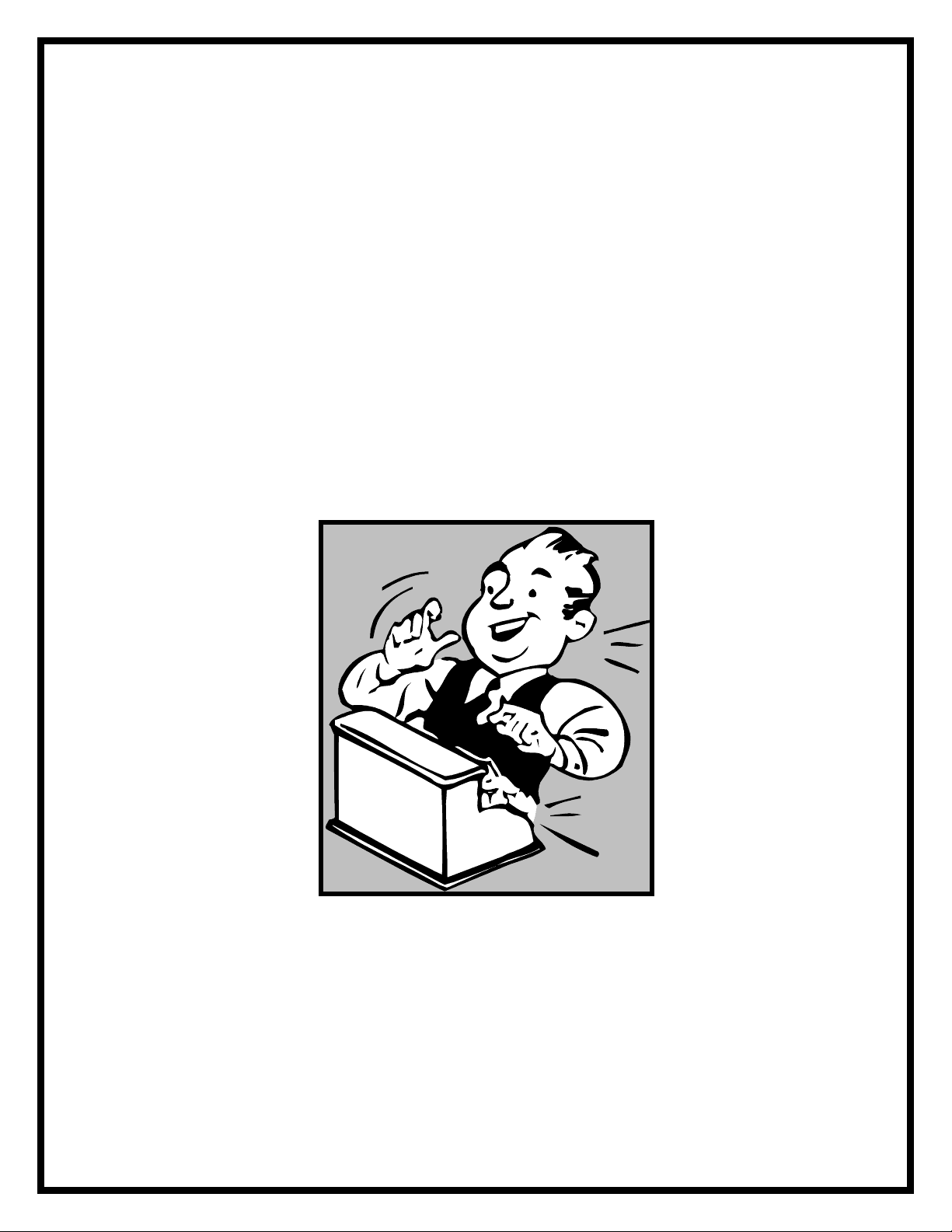
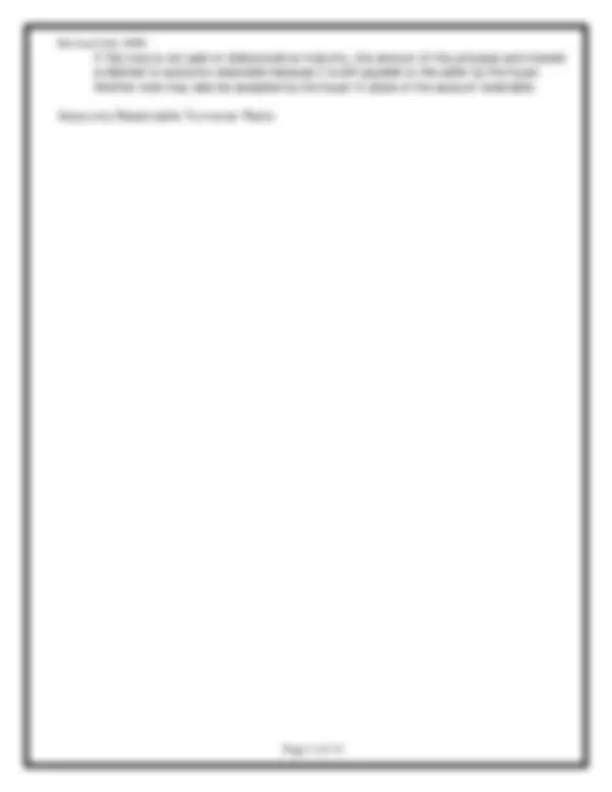
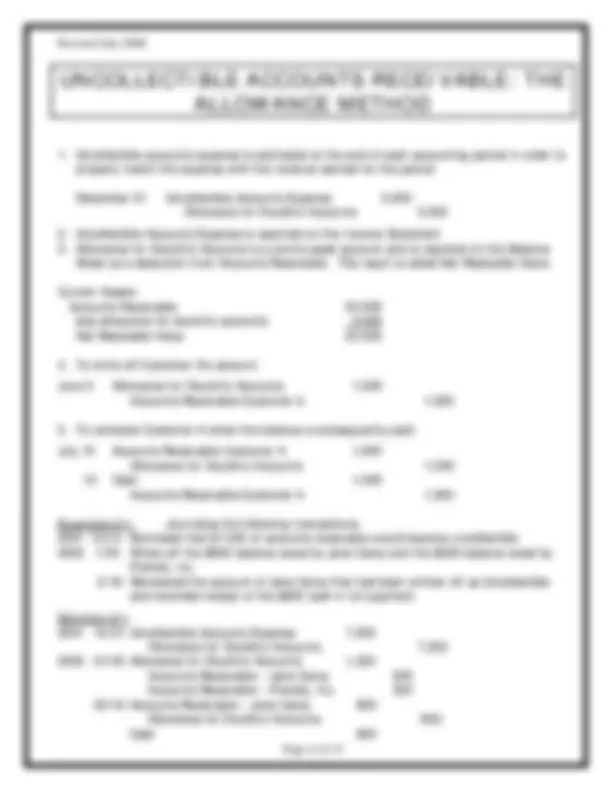
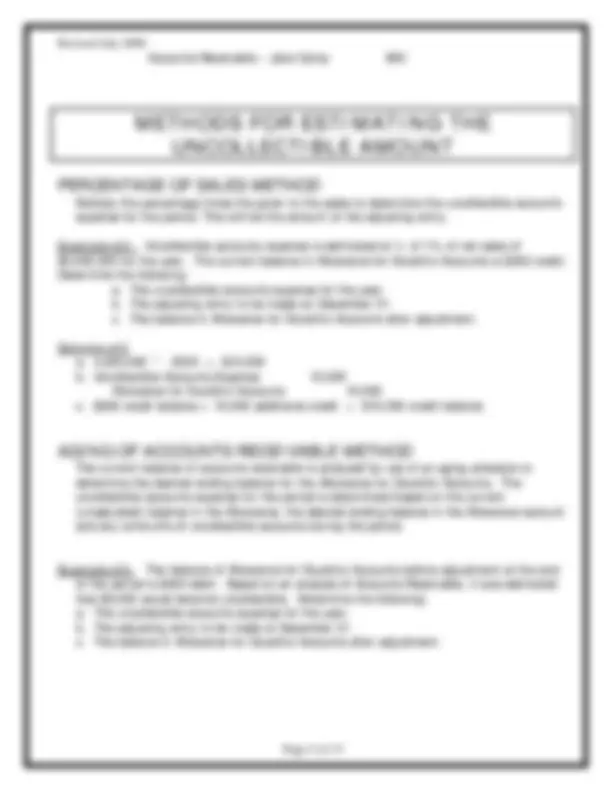

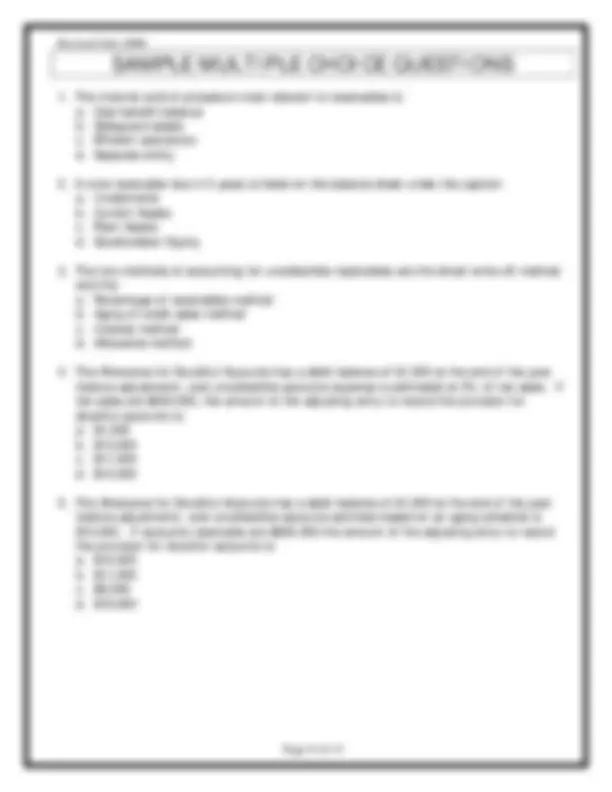
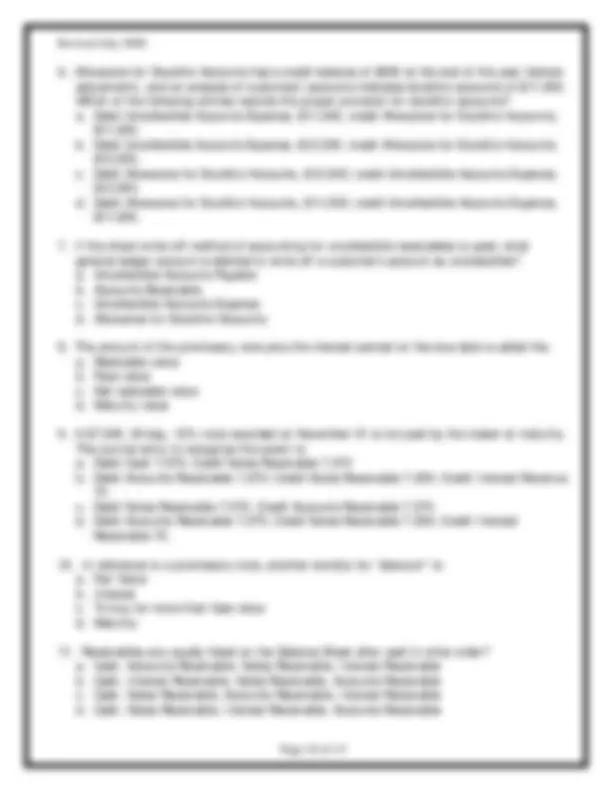
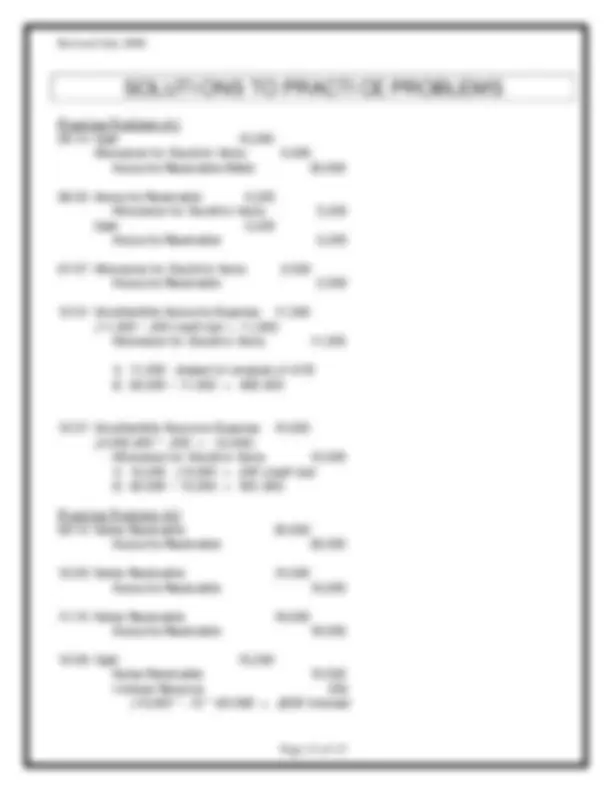
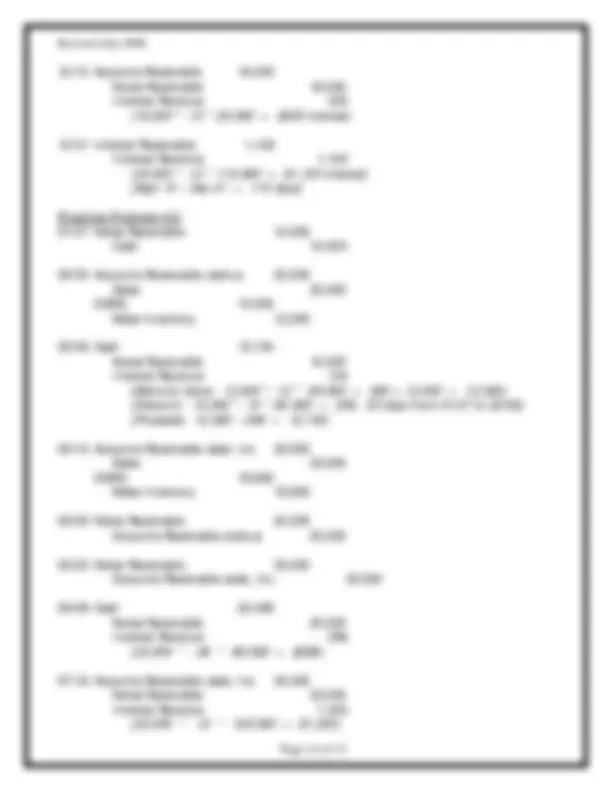
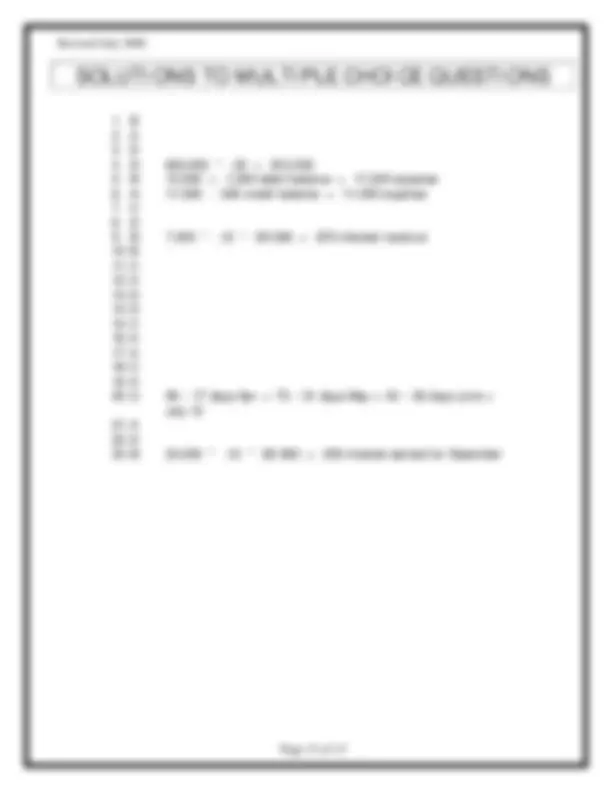


Study with the several resources on Docsity

Earn points by helping other students or get them with a premium plan


Prepare for your exams
Study with the several resources on Docsity

Earn points to download
Earn points by helping other students or get them with a premium plan
Community
Ask the community for help and clear up your study doubts
Discover the best universities in your country according to Docsity users
Free resources
Download our free guides on studying techniques, anxiety management strategies, and thesis advice from Docsity tutors
Material Type: Notes; Class: INTRODUCTION TO FINANCIAL ACCOUNTING; Subject: Accounting; University: Harper College; Term: Unknown 2008;
Typology: Study notes
1 / 15

This page cannot be seen from the preview
Don't miss anything!










Accounts Receivable: Result from sales on account (credit sales), not cash sales. May also result from credit card sales if there is a delay between when sale is made and when the cash is received from the credit card company.
Accounting for Uncollectible Accounts: Not all sales on account result in cash being collected from the customer. The Allowance Method debits bad debt expense in the period when the sale is recorded and credits a contra-asset account, Allowance for Uncollectible Accounts. When a specific account is determined to be uncollectible, the Allowance is debited and Accounts Receivable is credited. The Direct Write-off Method debits bad debt expense and credits Accounts Receivable in the period when a specific account is determined to be uncollectible. The Direct Write-off Method violates the matching principle because it does not match revenues and expenses in the same period.
Determining the Amount of Uncollectible Receivables and Bad Debt Expense: The Percent of Sales Method uses one income statement account, Sales, to estimate the change in another income statement account, Bad Debt Expense, for the period. This is the amount of the adjusting entry required. The balance in the Allowance account is then the balance in the ledger before adjustment plus the adjusting entry for bad debt expense. The Percent of Receivables Method uses the balance in one balance sheet account, Accounts Receivable, to estimate the balance in another balance sheet account, Allowance for Uncollectible Accounts, at the end of the period. The adjusting entry for bad debt expense is the difference between the balance in the ledger before adjustment and the estimated balance in the allowance account.
Accounts Receivable on the Balance Sheet: Allowance account is deducted from Accounts Receivable to determine Net Realizable Value.
Notes Receivable: Notes Receivable may be accepted by the seller in payment for a sale or to replace an account receivable from a prior sale. Notes bear interest for their term which is paid at the end of the term, the maturity date. Interest rates are typically stated as a percent per annum, that is, as a yearly or annual rate. Interest revenue is earned as time passes, regardless of whether payment has been received. Interest revenue for outstanding notes receivable is typically accrued at the end of the year, although it may be accrued at the end of a quarter or month.
December 31 Uncollectible Accounts Expense 5, Allowance for Doubtful Accounts 5,
Current Assets: Accounts Receivable 25, less allowance for doubtful accounts 3, Net Realizable Value 22,
June 5 Allowance for Doubtful Accounts 1, Accounts Receivable-Customer A 1,
July 10 Accounts Receivable-Customer A 1, Allowance for Doubtful Accounts 1, 10 Cash 1, Accounts Receivable-Customer A 1,
Example #1: Journalize the following transactions. 2001 12/31 Estimated that $7,000 of accounts receivable would become uncollectible. 2002 1/05 Wrote-off the $800 balance owed by Jane Camp and the $500 balance owed by Friends, Inc. 3/18 Reinstated the account of Jane Camp that had been written off as Uncollectible and recorded receipt of the $800 cash in full payment.
Solution # 2001 12/31 Uncollectible Accounts Expense 7, Allowance for Doubtful Accounts 7, 2002 01/05 Allowance for Doubtful Accounts 1, Accounts Receivable – Jane Camp 800 Accounts Receivable – Friends, Inc. 500 03/18 Accounts Receivable – Jane Camp 800 Allowance for Doubtful Accounts 800 Cash 800
Accounts Receivable – Jane Camp 800
Multiply the percentage times the given to the sales to determine the uncollectible accounts expense for the period. This will be the amount of the adjusting entry.
Example #2: Uncollectible accounts expense is estimated at ¼ of 1% of net sales of $4,000,000 for the year. The current balance in Allowance for Doubtful Accounts is $300 credit. Determine the following: a. The uncollectible accounts expense for the year. b. The adjusting entry to be made on December 31. c. The balance in Allowance for Doubtful Accounts after adjustment.
Solution # a. 4,000,000 * .0025 = $10, b. Uncollectible Accounts Expense 10, Allowance for Doubtful Accounts 10, c. $300 credit balance + 10,000 additional credit = $10,300 credit balance
The current balance of accounts receivable is analyzed by use of an aging schedule to determine the desired ending balance for the Allowance for Doubtful Accounts. The uncollectible accounts expense for the period is determined based on the current (unadjusted) balance in the Allowance, the desired ending balance in the Allowance account and any write-offs of uncollectible accounts during the period.
Example #3: The balance of Allowance for Doubtful Accounts before adjustment at the end of the period is $400 debit. Based on an analysis of Accounts Receivable, it was estimated that $9,000 would become uncollectible. Determine the following: a. The uncollectible accounts expense for the year. b. The adjusting entry to be made of December 31. c. The balance in Allowance for Doubtful Accounts after adjustment.
On July 17, 2001, received a $12,000, 90-day, 10% note on account from Adams Co
Due Date: Term of the note = 90 days Days remaining in July 31 – 17 = 14 days Remaining term of the note 76 days Days in August 31 days Remaining term of the note 45 days Days in September 30 days Remaining term of the note 15 days
Since the remaining 15 days are less than the 31 days in October, the note is due on October 15.
Interest: Calculated as Principal X Rate X Time $12,000 * .10 * 90/360 = $
Time is calculated as the term of the note divided by 360 days for the year. Time is always based on a 360-day year.
Maturity Value : Calculated as Principal + Interest $12,000 + $300 = $12,
Journal Entries: 07/17 Notes Receivable 12, Accounts Receivable 12,
10/15 Cash 12, Notes Receivable 12, Interest Revenue 300
Dishonoring the Note: If the maker of the note failed to pay (dishonored) the note on October 15, the following entry would be made:
10/15 Accounts Receivable 12, Notes Receivable 12, Interest Revenue 300
Note that the differences between the two entries for 10/15 are the account to be debited.
Adjusting Entries for accrued interest: At the end of the accounting period, in order to comply with the matching principle, interest must be accrued for the number of days between the most recent interest payment date and the end of the accounting period using the calculation method shown above.
Example #4: Journalize the adjusting entry for accrued interest on December 31 for the following outstanding notes receivable. Journalize the receipt of the amount due on the due date for each note.
Solution #
12/31 Interest Receivable 550 Interest Revenue 550
Notes Receivable 12,
Notes Receivable 24,
Practice Problem #2: Journalize the following transactions
09/12 Received a $30,000, 12%, 120-day note on account. 10/09 Received a $15,000, 10%, 60-day note on account. 11/15 Received an $18,000, 15%, 30-day note on account. 12/08 Received the amount due on the note of October 9. 12/15 The note of November 15 was dishonored. 12/31 Accrued interest on the note of September 12.
(Maturity Value: 12,000 * .12 * 90/360 = 360 + 12,000 = 12,360) (Discount: 12,360 * .10 * 60/360 = 206; 30 days from 01/07 to 02/06)